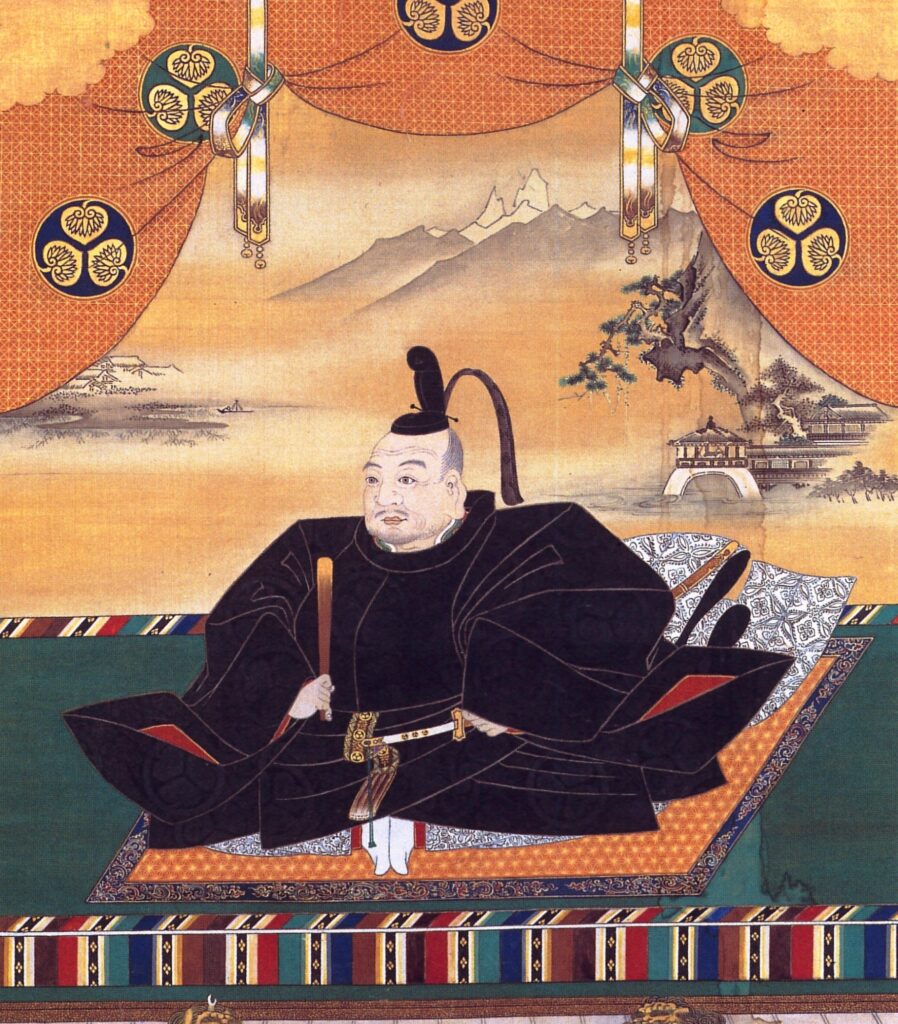

徳川家康 TOKUGAWA Ieyasu
1543 – 1616
The 3rd of 3 Great Unifiers of Japan
Tokugawa Ieyasu (1543-1616) is the third of the three great unifiers of Japan who completed the unification of Japan begun by Oda Nobunaga and Toyotomi Hideyoshi. He became shogun in 1603 after the victory at the battle of Sekigahara in 1600 where he destroyed the Toyotomi clan and made a big turning point in the history of Japan. He then founded Tokugawa Bakufu (shogunate), the government of the shogun in Edo (Tokyo) that maintained control of Japan for the next 265 years. His shogunate led to creating the basics of Japanese political and social organizations for people’s life. Tokugawa shogunate ruled Japan from 1603 to 1868. Ieyasu ruled for 13 years and died in 1616.
Early Life
In 1543, Ieyasu was born as Matsudaira Takechiyo, the son of Matsudaira Hirotada, in Okazaki (current Aichi prefecture). Ieyasu’s mother and father were only 17 and 15 when he was born, and separated later when Ieyasu was three, and she remarried. So Ieyasu had many half-brothers and sisters. His father was a lord of the Mikawa province in Aichi prefecture. Due to competing between regional warlords for national domination at the time, Ieyasu was sent as a hostage to secure an alliance between his clan and Imagawa family that based in current Shizuoka prefecture when he was six years old. But later he was kidnapped on the way to Imagawa family by Oda clan and had to spend much of his childhood years as a hostage.
It is said that Ieyasu and Oda Nobunaga might have gotten to know each other during this time. His father Hirotada was killed by his own retainer when Ieyasu was seven years old, in 1548. In the next year, Ieyasu was sent to Imagawa clan in Suruga from Oda as an exchange hostage. In 1557, he celebrated his coming of age and got married to Sena hime (later “Tsukiyamadono”) who is a niece of Imagawa Yoshimoto.
Career and Unification
In 1560, Oda clan beat Imagawa clan at the battle of Okehazama, and Ieyasu also fought for Imagawa, but Imagawa Yoshimoto was killed at the battle. Ieyasu tried to be independent from Imagawa clan. Ieyasu and Oda Nobunaga made an alliance in 1562 and reinforced their rear (Kiyosu alliance). Ieyasu had fused his power in Mikawa by 1567 and changed his name to Tokugawa Ieyasu. He then started campaigning with Nobunaga and expanded his influence and prosperity. By joining forces with Nobunaga who wanted to bring the country under unified rule, Ieyasu expanded his territory.
In the 1570s, Ieyasu was at battles with the powerful neighbor Takeda Shingen based in Kofu and occupied Suruga. Ieyasu allied with Shingen’s great enemy Uesugi Kenshin. He moved his home castle from Okazaki to Hamamatsu, participated in the battle of Anegawa, and won with Nobunaga against Asai and Asakura. Two years later, he was defeated by Takeda Shingen at the battle of Mikatagahara but revenged at Nagashino.
In 1579, because of doubt of betrayal, he killed his own wife Tsukiyamadono and let his own son Nobuyasu commit seppuku ritual suicide.
In 1582, Ieyasu finally defeated Takeda clan and Nobunaga gave him Suruga. In June of this year, Nobunaga was assassinated at Honnoji. The death of Shingen brought the areas such as Kai and Shinano that were ruled by Takeda clan, and Ieyasu attacked both of these areas and succeeded to rule them after beating Hojo family. In 1584, he fought with Nobunaga’s son Oda Nobukatsu against Toyotomi Hideyoshi, however, disasters such as earthquakes occurred in his territory and needed to be rebuilt there. Two years later, he gave up beating Hideyoshi and entered the Toyotomi administration.
He contributed many battles for Hideyoshi. Hideyoshi took Mikawa, Totoumi, Suruga, Kai, Shinano from Ieyasu away, but gave eight Edo period provinces of Kanto (Sagami, Musashi, Awa, Kazusa, Shimousa, Hitachi, Kouzuke & Shimotsuke). Hideyoshi also appointed Ieyasu Gotairo (council of five elders), and Ieyasu exercised his power as the head of them.
Hideyoshi died in Korea in 1598. Ieyasu then became one of the guardians of Hideyoshi’s son who was an infant yet. The struggling power and civil war against each other occurred by 1600 — two camps had formed, the eastern around Ieyasu and the western commanded by Ishida. In 1600 Ieyasu defeated Ishida at Sekigahara which had as many as 160,000 warriors prepared to fight the greatest battle in Japanese history, and was a complete victory for Ieyasu.
In 1603 the emperor granted him the title “Shogun”. This was the beginning of the Tokugawa shogunate that ruled Japan for the next 264 years, and Ieyasu began a central government in Edo. He was shogun only for two years and retired, gave the position to his son Hidetada, but he continued to take control of the government from behind.
He ordered to build Edo Castle in Edo that was to become the power base for future Tokugawa family, encouraged the samurai class to follow not only military arts but academic learning too. He pressed an active trade policy with the nations of Southeast Asia. He enacted Kinchu Narabani Kuge Shohatto (code of laws and ordinances regarding the conduct of the Imperial Court and the court nobles in Japan) that regulated emperors, and kuge was established and defined the relationship between kuge and samurai of the Edo period. Also, Buke shohatto (laws for the military families) and Ikkoku Ichijo Rei (the law for one castle per province) were established to control daimyo. Through these efforts, he established the ruling system of the Edo shogunate. Ieyasu actively promoted foreign trade. He permitted to open a trading house of East India Company (EIC) that traded and maintained colonies in Asia in the Netherlands and England in Hirado. He also awarded Shuinjo (shogunate license to conduct trade). On the other hand, Christianity was banned.
In 1615, Ieyasu attacked Osaka Castle and the Osaka Natsu no Jin (the Osaka summer campaign) occurred. The Tokugawa destroyed the Toyotomi clan which was the final threat to Tokugawa clan.
In 1616, Ieyasu was appointed from the Imperial Court as Dajodaijin (Chancellor of the Realm). He died this year at the age of 75.
Kamon
Tokugawa’s family kamon crest is “Mitsuba-aoi” which is designed in the motif of a futaba-aoi (two-leaf mallow), which belongs to Aristolochiaceae. Initially, the aoi-mon was not a special crest, and the bakufu was comparatively tolerant about using kamon, but it strictly forbade the use of aoi-mon, the kamon of Tokugawa clan, when the Tokugawa family became the Seii Taishogun (commander-in-chief of the expeditionary, great general who subdues the barbarians) and established the Tokugawa shogunate.
Nikko Toshogu
Nikko Toshogu is a Shinto shrine situated in Nikko, Tochigi prefecture to enshrine Ieyasu as “Tosho-daigongen”. The shrine has been listed as a World Heritage site since 1999. The original temple was rebuilt into the gorgeous temple complex by the third shogun Iemitsu in 1636, so that they can demonstrate the power of the Tokugawa Shogunate. One of the most popular sightseeing spots today.
.
.
.




